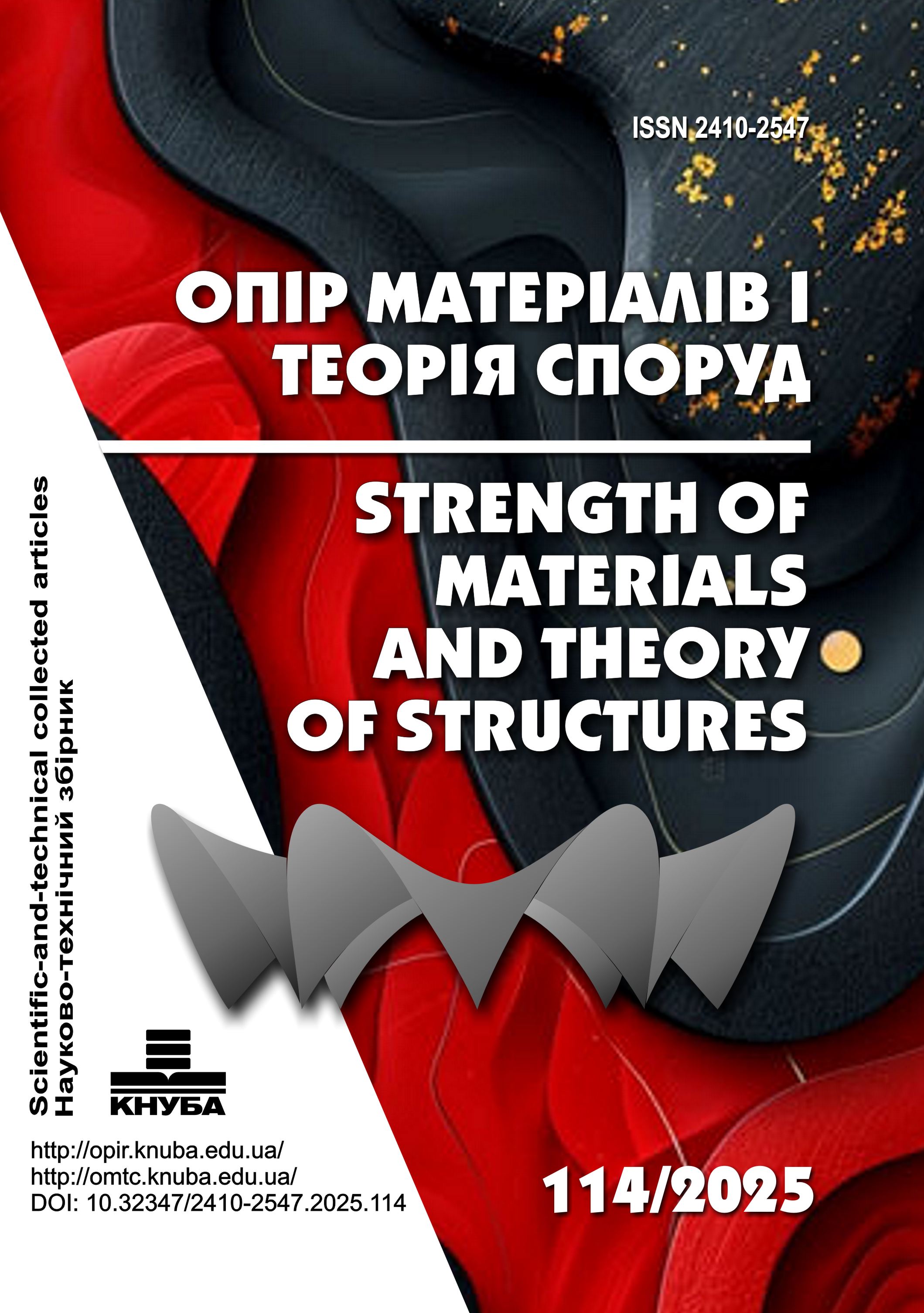Cylindrical shells in a wind flow: regression analysis of the wind pressure distribution coefficient
DOI:
https://doi.org/10.32347/2410-2547.2025.114.165-172Keywords:
modelling, shell, buckling, critical pressure, wind flow, regression, reduction coefficient, Open FOAMAbstract
The article considers the behavior of thin-walled vertical cylindrical steel shell structures (capacities range from 300 to 5000 m³) in a gas flow. Under wind load, the main danger for such structures is global or local buckling. In technical applications, in order to simplify buckling analysis, we usually perform a transition from a complex distribution of a wind pressure q2w to an equivalent uniform pressure q2we=q2w·kw. According to the design standard for storage tanks, it is assumed that the wind pressure distribution coefficient kw equals to 0.5 for all tanks, regardless of geometric parameters of the shells. However, this generalization is not accurate since the value of the coefficient depends on the parameters of cylindrical shells subjected to a gas flow with specific characteristics. The value adopted in normative documents does not provide the required level of reliability. However, under certain conditions, kw can be calculated as the ratio of the critical value of the external uniform pressure pcr2 to the critical value of the frontal wind pressure qcr2w. In this article, the critical frontal quasi-static wind load qcr2w (which causes shell buckling) is determined through numerical simulation of a wind flow in OpenFOAM using the k-ω Shear Stress Transport model. The critical uniform pressure pcr2 and, thus, buckling of the shell are determined by verifying the singularity of the tangent stiffness matrix of the corresponding shell structure. The kw coefficient is calculated using obtained values of the critical pressures, as described above. Using machine learning methods in the R statistical package, we have built a regression model, which allows us to calculate the kw coefficient using the geometric parameters of the shell. The adjusted Akaike Information Criterion (AICc) and the leave-one-out cross-validation method have been used to verify the adequacy of the model, along with the estimation of the mean squared error (MSE) and mean absolute error (MAE). The final regression model for the kw coefficient quite accurately corresponds to the data obtained through numerical simulation.
References
DBN V.2.6-198:2014. Stalevi konstruktsii. Normy proektuvannia. (Steel structures. Design standards). – K.: Minrehion Ukrainy, 2014. – 199 s.
VBN V.2.2 - 58.2 - 94. Rezervuary vertykalni stalevi dlia zberihannia nafty i naftoproduktiv z tyskom nasychenykh pariv ne vyshche 93.3 kPa. Vidomchi budivelni normy Ukrainy. (Vertical steel tanks for oil and oil products with saturated vapor pressure not exceeding 93.3 kPa. Departmental design codes of Ukraine). – K.: Derzhkomnaftohaz, 1994. – 98 s.
EN 1993-1-6:2007. Eurocode 3. Design of steel structures. Part 1-6: Strength and Stability of Shell Structures. – Brussels: European committee for standardization, 2007. – 94 p.
Yehorov E.A., Fedoriaka Yu.V. Yssledovanye voprosov ustoichyvosty stalnykh vertykalnykh tsylyndrycheskykh rezervuarov (Research on stability issues of steel vertical cylindrical tanks) // Metallycheskye konstruktsyy. – 2006. – № 1. – S. 89-97.
Resinger F., Greiner R. Buckling of wind loaded cylindrical shells — application to unstiffened and ring-stiffened tanks // Buckling of Shells: Proceedings of a State-of-the-Art Colloquium, Universität Stuttgart, Germany (Stuttgart, 6-7 May 1982). - Springer Berlin Heidelberg, 1982. – P. 305-331.
Alfutov N.A.Osnovy rascheta na ustoichivost upruhikh system. (Fundamentals of elastic structures stability calculating). Moscow: Mashinostroenie. - 1961.
Yegorov Y., Kucherenko O. Computer modelling of thin-walled shell structures with geometric imperfections // Strength of Materials and Theory of Structures: Scientific-and-technical collected articles. – K.: KNUBA. - 2023. – Issue 111. – P. 205-213.
Weller H.G., Tabor G, Jasak H., Fureby C. A tensorial approach to computational continuum mechanics using object-oriented techniques // Comput. Phys. – 1998. – Vol. 12 (6). – P. 620–631.
Blazek J. Computational Fluid Dynamics: Principles and Applications. – Oxford: Elsevier Science Ltd, 2001. – 440 p.
Menter F. R. Two-Equation Eddy-Viscosity Turbulence Models for Engineering Applications // AIAA Journal. – 1994. – Vol. 32 (8). – P. 1598-1605.
Menter F.R, Kuntz M. Langtry R. Ten Years of Industrial Experience with the SST Turbulence Model // Turbulence, Heat and Mass Transfer: Proceedings of the 4th International Symposium, Turkey (Antalya, 12-17 October 2003). – Begell House Inc, 2003. – P. 625 - 632.
Schmitt F.G. About Boussinesq's turbulent viscosity hypothesis: historical remarks and a direct evaluation of its validity // Comptes Rendus Mecanique. – 2007. – Vol. 335 (9-10). - P.617-627.
Revuz J., Hargreaves D.M., Owen J.S. On the domain size for the steady-state CFD modelling of a tall building // Wind and Structures. – 2012. – Vol. 15 (4). - P. 313-329.
Akpa O.M., Unuabonah E.I. Small-Sample Corrected Akaike Information Criterion: An appropriate statistical tool for ranking of adsorption isotherm model // Desalination. – 2011. – Vol. 272 (1-3). - P.20-26.
Portet S. A primer on model selection using the Akaike Information Criterion // Infectious Disease Modelling. – 2020. – Vol. 5. – P. 111-128.
Yates L.A., Aandahl Z., Richards S.A., Brook B.W. Cross validation for model selection: A review with examples from ecology // Ecological Monographs. – 2023. – Vol. 93 (1). – P. 1-24.
Downloads
Published
Issue
Section
License

This work is licensed under a Creative Commons Attribution 4.0 International License.
Authors retain copyright and grant the journal right of first publication with the work simultaneously licensed under a Creative Commons Attribution License that allows others to share the work with an acknowledgement of the work's authorship and initial publication in this journal.

